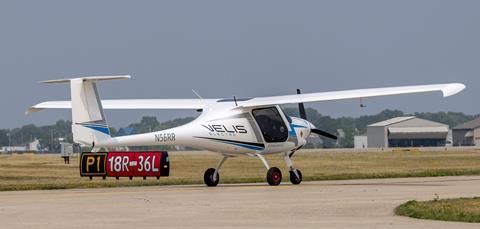Slovenian aircraft maker Pipistrel recently delivered the first four Velis Electro fully-electric aircraft to US customers under a Federal Aviation Administration (FAA) airworthiness exemption that allows the aircraft to be used in flight training for the first time.
The exemption, which the Textron eAviation-backed company received from the US regulator in March, is a precursor to a more-broad overhaul of certification requirements for light-sport aircraft (LSA) in general, and small electric aircraft in particular.
Pipistrel’s modest US launch holds promise for much, much more.
“The FAA has evaluated the aircraft, they have imposed certain obligations, so we have to keep track of what these aircraft are doing,” Pipistrel’s Tine Tomazic, director of engineering and programmes, told FlightGlobal on the sidelines of Aero Friedrichshafen on 17 April.
“We are in constant contact with the FAA so it’s a stick-and-carrot situation but all in all it’s extremely positive because there is no more obstacle” to the company’s plans to take the US flight training scene by storm.

Pipistrel’s Velis Electro was the first commercially available, all-electric aircraft to secure certification anywhere, following European Union Aviation Safety Agency approval for the two-seat type in 2020. And so far, the company has delivered 100 airframes to customers in 30 countries.
Flight training in electric aircraft has been touted as a lower-cost, sustainable alternative to learning to fly in traditional fossil-fuel single-engined piston aircraft like Textron’s Cessna Skyhawk, which has dominated the pilot training scene for decades.
As the industry has been looking at ways to reduce its carbon footprint, the FAA has in recent years also reconsidered rules that could make it easier for new propulsion systems to become certificated.
And a big step was taken last July, when the US regulator published its proposed “Modernization of Special Airworthiness Certification”, also known as MOSAIC, rule. MOSAIC expands the definition of LSAs to include heavier and faster models, and more importantly for Pipistrel, it would remove the requirement that an LSA must have a conventional piston engine.
Under the approach, the FAA proposed allowing higher stall speeds than those permitted today – the suggestion is to increase the stall speed limit to 54kt (100km/h) from 45kt – and bringing aircraft weighing as much as 1,363kg (3,000lb) into the light sport aircraft regulatory framework. Currently the limit for light sport land aircraft is 600kg.
The FAA has said the amendment to the specifications “enable enhancements in safety and performance and would increase privileges under a number of sport pilot and light-sport aircraft rules”.
For Pipistrel, that means cash in the bank.
“We’ve been given direct feedback that electric aircraft are very much welcome” in the USA, Tomazic says. Following the first four, “more are coming”.

Flight schools are its biggest target market, but Pipistrel has also been exploring other sectors for its electric aircraft. Last October, the US Air Force said it would be leasing two Velis Electros under its Agility Prime effort, which aims to assess potential military applications for battery-powered aviation.
The Velis Electro has lower operating costs than a fossil-fuel-powered aircraft, in part because its batteries only have an endurance of about an hour of what the company calls “active minutes” – the time the engine is actually running. The aircraft’s engine is engineered to stop when it is not moving on the ground, for example at a holding point. Charging the craft also takes about an hour.
TEXTRON INVESTMENT
Textron Aviation bought Pipistrel in April 2022 in a €218 million ($238 million) all-cash deal, bringing the operation into the US airframer’s eAviation business unit, its newest. It has kept Pipistrel as a distinct brand, alongside fellow fixed-wing aircraft manufacturers Beechcraft and Cessna.
That investment gave the company space and room to grow on several fronts, Tomazic says.
“We are adding floor space on the production side, we are adding floor space on the research and development side, the team is growing, and the aftermarket segment is growing the fastest now,” he says.
The company has begun a battery refurbishment and overhaul programme, so that when it is time for a new battery in the airframe, that battery can be replaced more cost-effectively.
“Going forward, certain things make absolute sense to keep internalised and batteries are definitely a technology that we consider absolutely core,” he says.
The company’s battery lab is constantly screening new cells that appear on the market in the automotive space, or other industries.
“We are replaying actual Velis Electro flights on those new cells to see how they perform, how they heat up or not, how they age, and even how they fail. The battery is the single most expensive component on the plane, so the economics of the battery will really define the economics of the whole flying activity.”
The aircraft’s certification required a battery replacement at 500h. But with experience as well as newer generations of batteries, the company expects cells will last between 1,000h and 1,500h, depending on the way in which the aircraft is used.
“So all of a sudden, you have the same expense spread over a period three times as long,” he says.
That is music to flight students’ ears, seeing as the cost of training is usually the biggest barrier to career entry and increased diversity in the aviation industry.
Once the FAA’s MOSAIC rules are in place – expected to be this summer after an extended comment period which ended in January – Pipistrel will no longer need its exemption, and the electric aviation sector will be off to the races.
“It’s a major, I would say historic milestone, because with our exemption, the US pretty much opened up electric flight to everyone and anyone without any special requirements,” Tomazic says. “You don’t have to be a scientist, you don’t have to be employed by a star-tup, you don’t have to be an eVTOL dreamer.
“Anyone can do it, and I think it’s a big deal for aviation at large.”






















![[Photo] Korean Air K-UAM](https://d3lcr32v2pp4l1.cloudfront.net/Pictures/100x67/7/3/1/101731_photokoreanairkuam_478072.jpg)




















